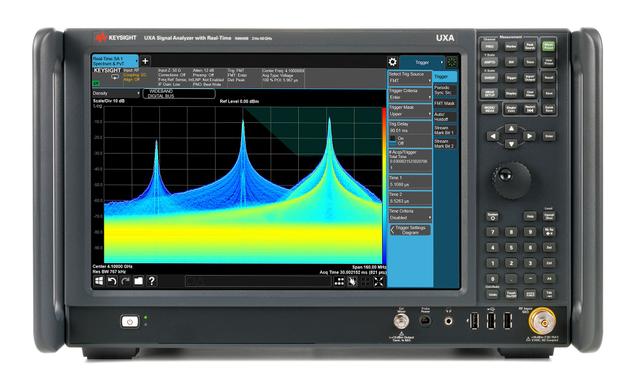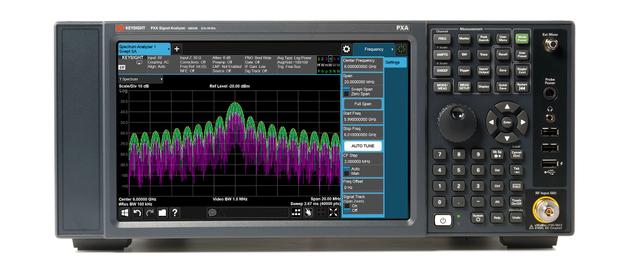Keysight Spectrum Analysers
Electro Rent partners with Keysight to offer high-quality test and measurement equipment rentals. Designed for testing signals in a variety of applications, these instruments offer quick yet reliable measurements, ideal for solving complex RF and microwave spectrum analysis problems and more.
Featured Keysight Spectrum Analyzers
Frequently Asked Questions
What’s the difference between Spectrum Analyzers and Signal Analyzers?
Spectrum Analyzers and Signal Analyzers basically do the same thing, they measure RF signals over a frequency range. Spectrum Analyzers are swept-tuned RF receivers that provide a variety of measurements and display the signals amplitude vs. frequency. A signal analyzer is a more accurate term for today’s instruments that combine swept-tuned features with vector analysis that also provides the phase information of the signal. A quick way to tell if the analyzer has signal analysis capability is to see if it can make in-channel measurements like EVM or has a modulation bandwidth specification.
What are the classes of Keysight Signal and Spectrum Analyzers?
The classes of Keysight Spectrum Analyzers generally refer to the frequency coverage and measurement accuracy of the instruments. Measurement accuracy refers to specifications like amplitude accuracy, phase noise, dynamic range and more. Here is a table listing the frequency coverage of the Keysight Spectrum & Signal Analyzer Series.
In general, the higher the frequency coverage, the higher the cost of the instrument. So, each of the series has a range of models to cover most customer use cases.
| SERIES NAME | MODEL | LOWER FREQUENCY | |||||||||
| UXA | N9041B | 2 Hz | 90 GHz | 110 GHz | |||||||
| UXA | N9040B | 2 Hz | 8.4 GHz | 13.6 GHz | 26.5 GHz | 32 GHz | 44 GHz | 50 GHz | |||
| PXA | N9030B | 2 Hz | 3.6 GHz | 8.4 GHz | 13.6 GHz | 26.5 GHz | 32 GHz | 44 GHz | 50 GHz | ||
| MXA | N9021B | 10 Hz | 32 GHz | 44 GHz | 50 GHz | ||||||
| MXA | N9020B | 10 Hz | 3.6 GHz | 8.4 GHz | 13.6 GHz | 26.5 GHz | 32 GHz | 44 GHz | 50 GHz | ||
| EXA | N9010B | 10 Hz | 3.6 GHz | 7 GHz | 13.6 GHz | 26.5 GHz | 32 GHz | 44 GHz | |||
| CXA | N9000B | 9 kHz | 3 GHz | 7.5 GHz | 13.6 GHz | 26.5 GHz | |||||
| BSA | N9321C | 9 kHz | 4 GHz | ||||||||
| BSA | N9322C | 9 kHz | 7 GHz | ||||||||
| BSA | N9323C | 9 kHz | 13.6 GHz | ||||||||
| BSA | N9324C | 9 kHz | 20 GHz |
If you know your desired frequency range, Electro Rent makes it easy to find matching products with customizable search options.
How do I choose the right Keysight Signal / Spectrum Analyzer?
Here are the main performance features when selecting an analyzer:
- Frequency range – Generally the first parameter in the selection of a spectrum analyzer is the frequency range. Make sure not only to cover the frequency of the highest signal, but also higher harmonics that you may need to observe. For example, if your highest signal is at 6 GHz, are there harmonics at 12 GHz or other mixing products to consider?
- Amplitude accuracy – Amplitude accuracy refers to the accuracy of the power measurements displayed on the analyzer. This measurement is important for many applications including EMC, EMI, noise figure, and many more.
- Dynamic range – The analyzer’s dynamic range is the ratio of the largest signal to the smallest signal represented in dB.
- Phase Noise – A spectrum analyzer’s phase noise contribution will limit the ability to make phase noise measurements. For example, an analyzer with a phase noise specification of -130 dBc/Hz will not be able to characterize a signal with a phase noise of -145 dBc/Hz. (Measured at the same frequency and offset). Phase noise will also contribute to other measurement functions like EVM.
- Hardware options. These options may not be automatically included with spectrum analyzer models. They are largely application dependent and need to be specified for every job. Here is a list of common hardware options:
- Attenuators (mechanical and electronic)
- Preamps
- Demodulation capability
- Tracking generator
- Precision frequency reference
What is the difference between spectrum analyzers and network analyzers?
Spectrum analyzers examine an outside RF source for the nature of the signal and network analyzers measure the performance of RF components. Network analyzers are also known as Vector Network Analyzers or VNAs. VNAs have generally have either 2 or 4 ports for measuring devices. Spectrum or signal generators have one port - an input port to measure the RF signal. Occasionally, a spectrum analyzer will have an additional port called a tracking generator that can be used to measure simple devices like filters. Tracking generators are only found on the Keysight BSA and CXA series.
What is the difference between an oscilloscope and a spectrum analyzer?
When electrical patterns are observed, we look at them with reference to a time scale. This time scale allows us to see the timing of the electrical signal, how it changes, and how it compares to other signals in a circuit. When we reference signals to a time scale, we say it’s in the time-domain. Time-domain measurements of signals are performed with oscilloscopes. Spectrum and Signal Analyzers examine the power of an RF signal in the frequency domain. So, where an oscilloscope will measure the amplitude of a signal vs time on an X-Y scale, a spectrum analyzer will measure the RF power on an X-Y scale over the frequencies we ask it to examine. The RF power is represented on the Y-axis and the frequency on the X-axis.








